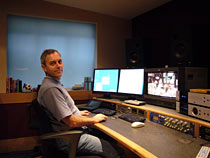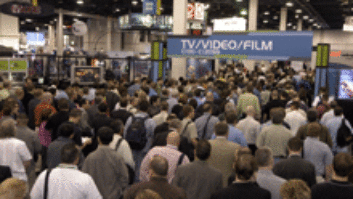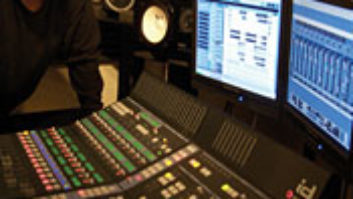
Engineer David Woolley in his Thornquest post-production facility
Universal Motown recently released Live at Last, Stevie Wonder’s first-ever live concert to be released on DVD and Blu-ray. The concert, which was recorded last autumn at the O2 Arena in London, was captured for posterity by Tim Summerhayes onboard the Red TX MobileOne. David Woolley (pictured) then mixed the audio at his Thornquest post-production facility in West Sussex.
Woolley carried out the mix process using a SADiE PCM-H128 multichannel recorder/editor and a SADiE LRX2 location recording workstation. Woolley prefers to mix “in the box,” moving from one SADiE unit to another, rather than use an external console or a DAW controller.
“Tim recorded 96 tracks at the concert, but a few were not used because the set list for each show is quite fluid,” Woolley explains. “That many tracks in 5.1 maxes out what a H128 can achieve, so I decided to use the LRX2 as well. I split the work so that the H128 submixed the 90 stage feeds into 32 outputs, effectively creating a manageable and perfect multitrack. There was a fair bit of subtle patching up because the musicians, who were excellent, were following Stevie’s ad-libs on stage and sometimes needed a little help. The Cedar retouch worked wonders fixing occasional feedbacks, clicks and crackles.
“The H128 was outputting 64-channel MADI to the SADiE LRX2 and I was probably using about 32, which were effectively remixed stems. I’d have half a dozen for drums, for example, and a few more for guitars, plus a few other inputs for mixed keyboards, a dozen or so for the audience as well as some for the effects sends. The LRX2 was my console, mixing the 32 stems to 5.1 but crucially being able to record them raw for later replay at mastering.”
Once Woolley had completed his mix, the project transferred to Metropolis Studios in West London for the mastering stage. Woolley remained involved, working alongside Metropolis mastering engineer Tim Young.
“Rather than sending in some rendered files, I gave Tim the SADiE LRX2 project, which was still open,” Woolley explains. “This allowed us to audition and tweak my 5.1 and stereo mixes so the final balance was actually done at Metropolis with the six discrete files being rendered by Tim through his SADiE mastering equipment. I wanted to work this way for two reasons.
“Firstly, I wanted to give Tim every opportunity to get into the mix and change whatever he wanted at source. One of the roles of a mastering engineer is to correct deficiencies in the remix, so I thought it would be better to actually mix at the mastering session and the compatibility between SADiE systems gave us the opportunity to do that. Secondly, I wanted to review my mix through the excellent Metropolis monitoring and acoustics and still be able to correct any changes from my home studio. This approach worked really well and I’ll certainly do it again.”
For more information, visit SADiE’s PCM-H128 and LRX2 pages, and www.thornquest.com.



